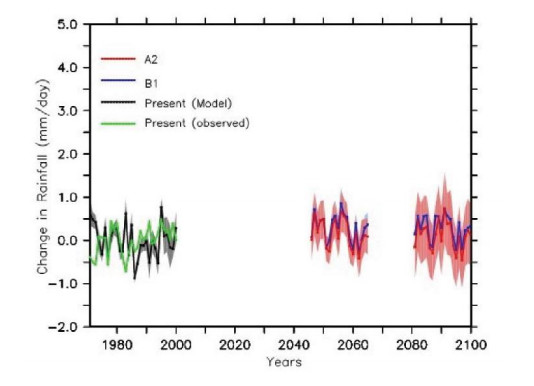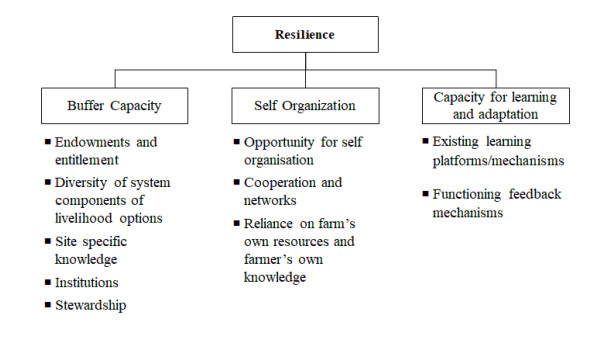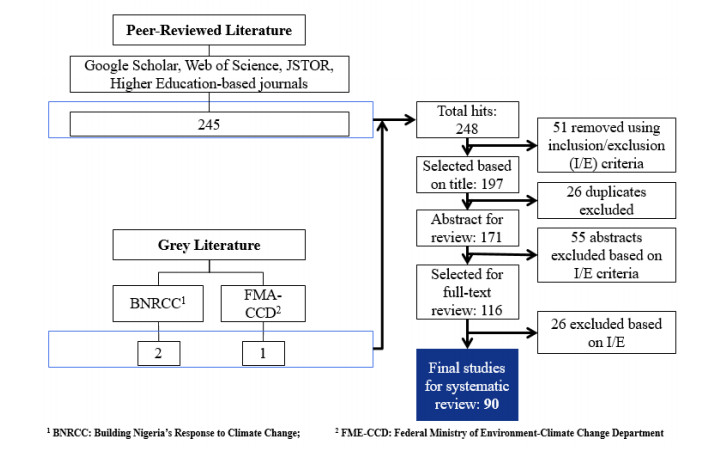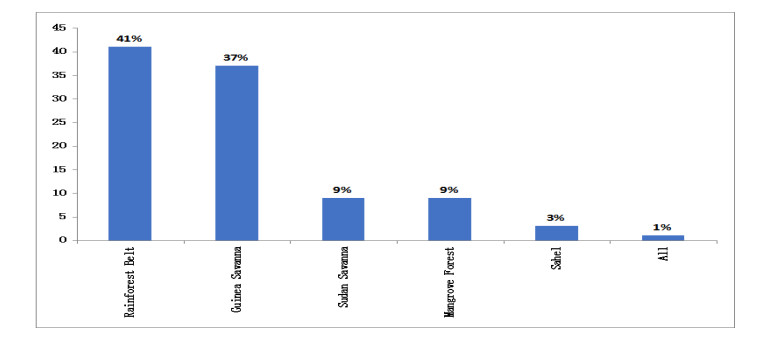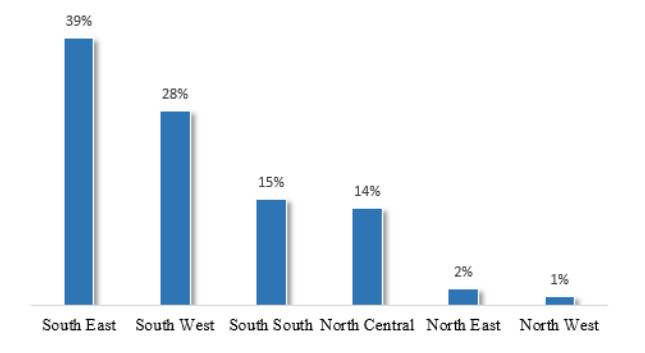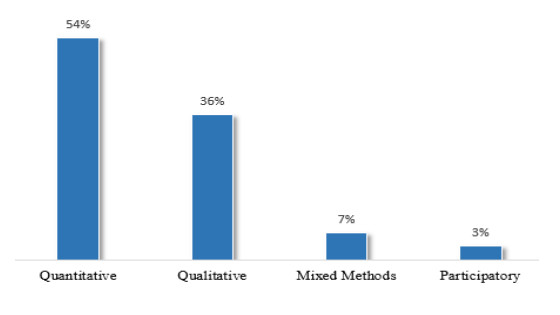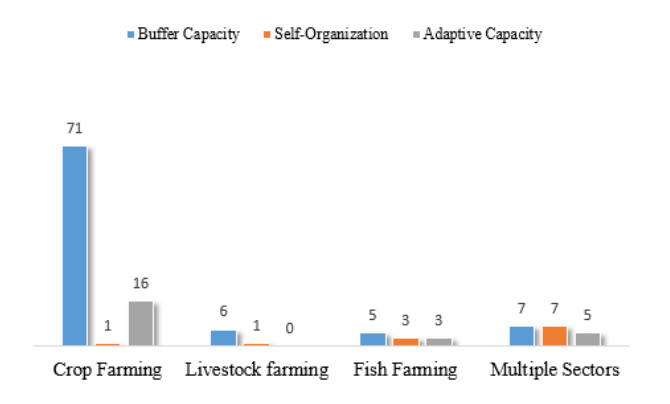The changing climate is adversely affecting the productivity and livelihoods of Nigerian smallholder rural farmers. Several studies predict worsening outcomes for future climate events, for example heat waves, drought and intense precipitation. Farmers are required to adopt several measures to thrive, given the observed or expected climate change events. Existing studies about the interaction between climate change the agriculture sector has focused evaluating the bi-directional causal relationships, and identifying adaptation measures, but research on the climate resilience aspect of these adaptation measures is missing, or at best, low. This study aims to fill this gap in knowledge by assessing resilience and contribution to sustainability of farmer-adopted measures aimed at addressing risks posed by climate change. We conduct a systematic review of 95 studies concentrating on climate adaptation by smallholder rural farmers in Nigeria in the period 2010 to 2019. We assess the climate resilience of adaptation measures using the Ifejika-Speranza Resilience Check Toolkit. Our findings show that farmers are using climate-resilient adaptation measures; however, we could not ascertain how these have led to sustainable agricultural systems, since it is not the focus of the current study. Our findings show that majority of the adaptation studies in Nigeria are focused on crop farming subsystem. The major agricultural ecosystems and the broad adaptation areas are: Crop farming (improved soil and land management, crop-specific Innovation, water management practices, climate information services and education, access to finance, and off-farm diversification), livestock farming (improved livestock management systems, improved breeding strategies, sustainable health improvement, proper feed formulation early maturing and heat-resistant bird varieties), and fish farming (water harvesting measures, organic material, quick-maturing varieties).
1.
Introduction
Change in the global climate is having extreme impacts on the environment and human systems [1,2]. Farmers face substantial risks due to climate change, for example, variable precipitation patterns during planting seasons and intense weather phenomena [3,4]. The rise in risks and vulnerabilities may have adverse effects on the livelihood of rural farmers; hence there is urgent need for adaptation measures to manage risks and vulnerabilities resulting from adverse weather and climate phenomena [5]. The climate change and variability discourse have occupied center stage, globally, in recent times, due to the associated rising risks, dangers, and universality of its impacts [6]. Climate change is majorly characterized by prevalence of severe weather and temperature events, and varying rainfall patterns [7]. Efforts to deal with the current impacts of climate change, will require adaptation and mitigation responses [2,8]. Climate adaptation refers to a system’s capacity to accommodate changes in the climate, together with variability and extremes, to limit possible damage, to exploit the opportunities, and or deal with the outcomes [1,9].
Developing countries, especially in Africa, face substantial risks from climate change due to increased exposure and inadequate adaptive potential [10]. Agricultural sector, being climate-sensitive, dominates economic activities in these countries, hence increasing the risks faced by these countries. Other factors increasing include underdeveloped education and health institutions, high incidence of poverty, unsustainable growth in population, and inadequate infrastructure [11]. Following the literature on the susceptibility of African countries to climate change impacts, this study focuses on Nigeria.
Recently, adaptation to climate change has clearly become an important domain of practice and research. Adaptation in agricultural systems can be grouped into two broad areas; planned and autonomous adaptation. Planned adaptation includes measures and strategies carried out consciously, to foster the system’s capacity to adapt. Under planned adaptation, for example, farmers adopt purposive selection and distribution of crops across various agro ecological zones and replacing old crops with new crop varieties. Autonomous adaptation, on the other hand, is reactionary in nature. Variable rainfall patterns that result in changes in planting dates by farmers, hence reactionary, can be regarded as autonomous adaption [12,13].
Our knowledge of adaptation is little; despite an increasing number of studies suggesting various assessment and adaptation measures, not many studies have systematically evaluated existing adaptation measures, quantitative and qualitatively, as well as adaptation measures’ contribution to sustainability and resilience, specifically at the national level [14]. Is adaptation occurring? What adaptation measures are in place? Does adaptation contribute to resilience? There are different views and frameworks of what constitutes resilience building to climate change. However, the crucial factors amongst these frameworks focus attention on buffer capacity, participatory processes and knowledge co-production, stakeholder and decision makers’ involvement [15].
1.1. Climate change and Nigerian Agriculture
Nigeria has already witnessed increased air temperatures in the recent past (1971–2000). During this time, in Nigeria, minimum temperatures showed a faster increase of +0.8 ℃, which is more than the maximum temperatures which rose by +0.5 ℃ [16]. This situation is further exacerbated in the context of global warming, which is forecast to reach 1.5 degrees Celsius between 2030 and 2052 [17] under two different scenarios—A2 and B1. A2 and B1 are scenarios for future climate projections downscaled from the Global Circulation Models and used by scientists from the Climate Systems Analysis Group at the University of Cape Town South Africa to predict the future impacts of climate change on Nigeria’s economy under two scenarios [16]. The first scenario, A2, assumes that the world will consider more regional economic development in the future while the second scenario, B1, assumes that there would be dominance of environmental factors and global considerations in the future. See Abiodun et al. for more details and explanations of these scenarios [16].
Figure 1 presents information on the annual predicted minimum and maximum temperature changes during the periods: 2046–2065 and 2081–2100, using different scenarios for Nigeria. The deviations are calculated with reference to the mean of present-day climate. The thick line represents the models' average, while the shaded area represents the area of one standard deviation away from the mean. In Figure 1, projected trends for Nigeria also show increased warming. This may likely occurrence of heat waves that will increase the rates of evaporation [16].
Figure 2 presents information on the annual predicted changes in rainfall (mm/day) during the periods: 2046–2065 and 2081–2100, using different scenarios for Nigeria. The deviations are calculated with reference to the mean of present-day climate. The thick line represents the models’ average, while the shaded area represents the area of one standard deviation away from the mean. The figure shows no specific trend in future rainfall deviations [16].
1.2. Nigerian food production in a changing climate
The Nigerian economy is largely agriculture-based. Agriculture accounts on average about 30 to 40 percent of the nominal GDP, and employs about 65 to 75 percent of the labor force, while providing various ecosystem services [18,19]. Agriculture and rural development are vital to the Nigerian economy; like in most developing countries, Nigerian agricultural systems depend mainly on rainfall. The future, including current, projected variations in the climate during different seasons makes Nigeria’s food production extremely susceptible [16,20]. Agricultural production consists mainly of cereals and tubers; in 2013, both cereals and tubers production contributed approximately 70 percent of total output in the agricultural sector. The production of cassava (a tuber crop) is a very important crop, due to ease of adjustment in its planting decision and high drought-tolerance. On the other hand, rice (a cereal crop) is planted in all eco-zones of Nigeria. Together, these crops have significant impacts on food security in Nigeria [21].
Agricultural productivity in Nigeria has recently experienced declines [21]. Smallholder rural farmers dominate the farming system in Nigeria, accounting for about 80 to 90 percent of producers. However, productivity is hampered by insufficient capacity to acquire necessary farm inputs such enhanced or improved crop varieties, fertilizers, irrigation and other production inputs. Also, agricultural productivity declines have been linked to climatic and weather variability or change, hence facing problems with food productivity arising from dependence on rain-fed farming worsened by low inputs [22,23]. Farmers should therefore adopt climate resilient adaptation measures to cope with, or reduce climate vulnerability [21].
1.3. Necessity of a systematic review on Nigerian farmers towards climate change adaptation practices
Several climate adaptation practices exist; however, academic literature is scarce on the effectiveness, sustainability and contribution to resilience of these adaptation practices, especially in Sub-Saharan Africa [24]. Adverse climate events in the form of variable rainfall, increased drought, intense heat in the northern arid region, and increased erosion in the southern rainforest parts of the country are reported to persist in Nigeria [25,26] thus requiring adaptation practices aimed at enhancing resilience. Farmers adopt different measures to cope with a changing climate; however, often times, the adopted measures may have negative impacts on the environment, especially on the biophysical, social and economic dimensions, hence not contributing to resilience and sustainability [27].
A review of the current literature is required to create knowledge on where adaptation is focused and areas requiring attention. This study also adds value by providing detailed information on the steps adopted for reviewed [28], which is missing in most review studies. Current systematic reviews have focused on other sectors, for example energy [29] and other countries and regions [30]. To the best of our knowledge, this study is the first to attempt a review of climate resilience of adaptation practices in Nigeria’s agricultural sector. This study identifies and classifies farmers’ adaptation practices across Nigeria. Publically available information—peer-reviewed, reports or documentation—will be used to analyze adaptation in Nigeria.
1.4. Aims and objectives
This study extends the existing literature by identifying and analyzing many of the recent studies, both gray and peer-reviewed literature on planned and autonomous adaptation to climate change. It covered important areas of climate change adaptation research and practices, with focus on assessing resilience-improving practices in the agricultural sector, and suggests which areas may need more attention. From the foregoing, this study will conduct an online search and summarize current studies on Nigerian farmers’ adaptation to climate change. The specific objectives include to:
1. ascertain which agricultural sectors, such as crop, fish, and livestock (including livestock) farming, have climate change adaption practices been focused or concentrated on in Nigeria;
2. determine the agro-ecological zones the current studies on climate change adaptation focused on in Nigeria;
3. categorize the resilience status of these identified adaptation practices in Nigeria.
The rest of this report is as follows: We present the methodological framework used for the literature search and review in section two. In section three, we present the systematic review and synthesis of the current research, following from our methodological framework, on Nigeria farmers’ practices aimed toward climate change adaptation. In section four, we present a detailed resilience check of adaptation measures. Section five of this paper presents a brief discussion and way forward. In addition, we provide appendices with relevant, supplementary information.
2.
Materials and methodological framework
We search and select studies for review, as well as use a resilience-check as a general framework to investigate how adaptation is taking place in Nigeria and contribution to climate resilience of these measures. This study improves on the current approaches to meta-analysis and enables a critical examination of how adaptation is taking place in Nigeria.
2.1. Describing resilient adaptation in the agricultural sector
We extend the current literature by focusing on resilient adaptation measures geared toward coping with climate change-related risks in agricultural ecosystems. For our purpose, resilience to climate change implies an individual’s, a social group’s or a socio-ecological systems ability to cope with disruptions resulting from climate extremes, while maintaining its basic form or method of functioning, ability for self-organization and the ability to learn and adapt to changes [31,32]., These are the 3 major dimensions of resilience. This definition cuts across sustainability in agricultural systems facing climate change impacts. In agricultural systems, sustainability implies the long-term ability to conserve or boost natural resources, quality of the environment, productivity, economic viability and be socially beneficial [32,33].
Following [15,32], we link the concept of resilience to study of livelihoods, focusing on the agricultural sector. We refer to livelihood as including the abilities, assets and tasks essential for a living. Dorward et al define livelihood functions as the welfare contributed by livelihoods, for example, food, earnings, insurance and poverty reduction [34]. With reference to livelihoods, resilience is dependent on one’s capabilities, social and natural conditions.
Assessing the climate resilience of adaptive measures brings up the subject of context-specificity, since social-ecological circumstances have spatial and temporal dimensions [9]. The toolkit we adopt for this study provides no explicit index for classifying adaptation practices, leaving the researchers room to objectively utilize it as a general framework for this paper. Hence, our study assesses the basic characteristics of adaptation measures based on existing literature, and objectively classify them according to the component through which it contributes to climate resilience.
From Figure 3, resilience can be divided into three components. These components are buffer capacity, self-organization and capacity for learning and adaptive management.
Buffer capacity: Within a livelihood context, this refers to the ability to withstand change, while taking advantage of the resulting opportunities to realize more desirable livelihood results such as poverty reduction. Self-organization: In self-organization, systems are assessed to see if they offer the opportunity for farmers to self-organize. Self-organization enables cooperation and networks among farmers with the advantage of reducing reliance on external parties for information, innovations, and financing. Farmers’ dependence on own talent and farm reserves cause for less reliance on external parties and quick decision making at the farm level. Capacity for learning and adaptive management: Implies an approach to management and openness to learning by the farmers. We briefly consider, where appropriate, the components social-ecological systems (SES) dimensions of these components. Considering the dynamism of SES, farmers continually alter their farm activities, while acquiring knowledge from peers on how to sustain and boost production. Adaptive management is important because it emphasizes the importance interpreting signals from the social and ecological systems and their management. For more details, see [15].
2.2. Literature search and selection criteria
To foster clarity and reproducibility, this study adopts the Preferred Reporting Items for Systematic Reviews and Meta-Analysis (PRISMA) framework. The PRISMA framework systematically guides researchers in the criteria for obtaining resources for a systematic review, inclusion and exclusion criteria, stepwise review process, data abstraction and analysis. The PRISMA framework has been used in many climate change systematic reviews (for example, see [30,35]). We conducted online literature search on relevant English language-published, peer-reviewed and gray literature, using databases such as Google Scholar (GS), Web of Science (WoS), JSTOR, Nigerian Higher Education-based Journals, Professional Association-based journals, and Government-owned Non-Governmental Organization-owned Repositories. We focus Open Access publications or documents.
We restrict our study period to the 2010 to 2019 period. Furthermore, this study considers literature on farmers’ adaptation practices aimed at coping with climate change-related impacts. We also account for various agricultural sectors, for example, crop farming, livestock farming, and fishery. This study further extends the adaptation criteria to account for sustainability in the form of resilience, hence, using several keyword combinations to obtain our resources for the systematic review. These keywords include: “Climate change (accounting for shocks, weather)”, “adaptation (accounting for resilience, vulnerability, and risk)”, “agriculture (accounting for crop, livestock, and fishery)”, and “sub-Saharan Africa”, “Nigeria”.
We identified 248 studies from the accessed databases during our initial search, consisting of peer-reviewed and gray literature (for example, working papers, project reports and conference proceedings). Table 1 present our literature selection criteria:
Figure 4 presents a schema of our literature search and selection procedure, leading to 90 studies.
3.
Results
3.1. Overview
A total of 248 studies were obtained from our literature search. Our selection criteria resulted in a final sample of 90 final studies reviewed—85 (94%) were peer-reviewed studies and 5 studies (6%) were gray literatures. According to Singh et al., the value in reviewing relevant gray literature on climate change studies lies on their ability to provide useful, area-specific information, policy-relevant responses, and practices which be ignored by peer-reviewed literature [37]. Our results show an increase in climate change adaptation studies since 2010, with the highest number of studies occurring in 2012, a year after the National Adaptation Strategy and Plan of Action on Climate Change for Nigeria (NASPA-CCN) and the Agricultural Transformation Agenda (ATA) were approved by the Nigeria’s Federal Government.
3.2. Climate change adaptation and agro-economic sectors
The final studies for the review are broadly analyzed based on farm-level adaptation and institutional or policy-level adaptation measures. Furthermore, the paper identifies a total of 13 distinct broad themes of adaptation, from 58 sub-themes. Table 2 presents the farm-level agro-economic sectors and the adaptation measures. Table 2 shows that 83.3% of the total papers analyzed reported practices under soil and land management in the crop sector as adaptation strategy to climate risk management. Crop-specific innovation (77.8% of the papers) was the second most common adaptation strategy for climate risk management reported by the papers. Water-linked management practices were reported 54.4% of the papers analyzed. In the livestock sub-sector, improved livestock management systems, improved breeding strategies and sustainable health management were the common broad strategies for climate change adaptation reported in the literature in Nigeria. Improved fishery management and improved fishing infrastructure featured prominently in the papers analyzed.
In Table 3, we find that 72 studies specifically focused on the crop farming sector and account for about 80 percent of the total studies reviewed, the rest are: fish farming (n = 5, 5.56 percent), livestock farming (n = 6, 6.67 percent), and studies that considered multiple sectors at once (n = 7, 7.78 percent). The focus of climate change adaptation research on the crop sub-sector could due to the dependence of majority of farmers on this sector and the vulnerability of the sub-sector to climate change.
3.3. Geographic coverage of adaptation studies
The geographical coverage of the studies reviewed is categorized according to agro-ecological zones, geopolitical zones and states in Nigeria. In Figure 5, 5 agro-ecological zones were identified; Guinea Savanna, Sudan Savanna, Rainforest Belt, Mangrove Forest and Sahel Savanna. About 41 percent of the studies focused on the Rainforest Zone, 37 percent of the studies focus on the Guinea Savanna Zone, 9 percent of the studies focus on the Sudan Savanna Zone, 9 percent of the studies focus on the Mangrove Forest Zone, 3 percent of the studies focused on the Sahel Savanna Zone, while 1 percent studied farmers’ adaptation in multiple zones.
In terms of the geopolitical zone coverage, all the 6 geopolitical zones in Nigeria were covered; Figure 6 reports that 39 percent of the studies focused on the South East region, 28 percent of the studies focus on the South West zone, 15 percent of the studies focus on the South South zone, 14 percent of the studies focus on the North Central zone, 2 percent focused on the North East zone and 1 percent focused on the North West zone.
3.4. Methodological and analytical approaches
3.4.1. Approaches
The studies under review applied four distinct analytical approaches. These are the qualitative, quantitative, mixed method and participatory approaches. The studies using qualitative approaches explore the literature and apply simple measures of central tendency such as means and percentages, while quantitative approaches advance beyond descriptive statistics and utilize quantitative analysis and models. Mixed methods approaches combine qualitative and quantitative approaches. Figure 7 reports that 54 percent of the studies utilized quantitative approaches, 36 percent of the studies utilized qualitative approaches, 7 percent used mixed method and 3 percent used participatory method.
3.4.2. Research methods and data analysis
Climate change adaptation research in Nigeria utilizes various research methods. The majority of studies used questionnaire surveys to elicit information from Nigerian farmers about their climate change adaptation practices. Few papers (3 papers) used a participatory approach to study climate change adaptation decisions of farmers. This paper presented the findings of these papers separately because of the grounded approach adopted in such studies. The researchers in these studies allowed themes to emerge from the locales instead of imposing their knowledge of adaptation on the people. Regarding quantitative analytical approach, our results show the probit and multivariate probit model, logit model and spatiotemporal trend analyses as the main analytical techniques.
4.
Resilience check
In this section, we analyze the reported adaptation measures employed by Nigerian farmers to address climate-related impacts within the 4 agricultural sectors under study, using the previously-defined resilience framework. In Table 4, in the appendix, we show the adaptation practices classified by agricultural sector and contribution to resilience.
4.1. Crop farming
4.1.1. Buffer capacity
4.1.1.1. Crop-specific innovation
Farmers facing increased environmental change can use crop diversification measures such as mixed cropping or intercropping practices to diversify farm-related risks. Rusinamhodzi et al. showed that intercropping could prevent total loss in farm output arising due to climate induced drought conditions [38]. Mixed farming practices, under climate change situations, that utilize indigenous crop diversity can foster resilience; since the crops must have adapted to local climatic conditions over time. They will thrive well and ensure sustenance of productivity at farm level [39,40]. Such crop diversification practices can provide resilience by restraining pests and diseases, due to diverse crops responding dissimilarly to climatic impacts and retaining functional ability relative to non-diverse cropping systems. This has the potential to improve food security, while sustaining or improving incomes for farmers [41,42].
Farmers also plant indigenous crop varieties that are well-suited for the immediate environment, where other varieties might fail [43,44]. Crop rotation maximizes the use of lands for the production of various crops, while reducing pests and diseases. Drought-resistant crop varieties: crop farmers in drought-prone areas adopt drought-resistant to guard against yield declines. Wheat planting in dry areas will thrive significantly better than dry season rice. Drought-resistant maize varieties cultivation has been found to increase productivity by 617 kg/ha and of 240 kg/ha compared to cultivation of non-drought-resistant maize varieties, in mild drought-prone areas [45]. Adjusting planting dates: variability in rainfall has been linked with largely responsible for poor productivity in Nigerian agricultural system [16]. To prevent crop production risks resulting from variability in rainfall, farmers vary planting dates whereby crops are planted before the start of rains, immediately after the first rains, and a few days after the rain. Staggering planting dates are done deliberately to pass around risk, by ensuring that any available rainwater will be utilized maximally by crops planted in dry fields [46,47]. Sustainable crop management practices such as crop diversification, new crop varieties, ecological pest management, seed and grain storage foster climate resilience through innovations in crop development. Considering innovative crop development activities, farm productivity is increased through the use of early-maturing and higher yielding crop species. Furthermore, farmers use drought-resistant crops as buffer against crop failure from the increased incidence of climate-induced droughts. Farmers also use pest or disease-resistant crop varieties to adapt to climate-related pest and disease attack. Adopting other crops for production, especially heat-resistant crops serve as a buffer against climate change-induced high temperatures and low precipitation [48,49].
4.1.1.2. Sustainable soil and land management
Practices that comprise sustainable soil and land management contribute to buffer capacity in diverse ways. For example, against soil erosion, reduction of organic content, condensation, and soil acidity are increasingly worsened by adverse climate and weather changes, like wind gusts and variation in precipitation rates [50]. Soil erosion results in the reduction of soil surfaces, organic matter and essential nutrient sources, leading to the crop supporting and production capacity of the soil. Sustainable soil and land management practices that contribute to sustenance of smallholder farmers’ livelihoods by controlling erosion through structural and vegetative barriers include tree planting, cover cropping, mulching, cross-slope [51]. Traditional tillage may be a useful measure for farmland weeding and the control of pests, however, it may not be useful in climate change-prone areas; it may disrupt the physical quality of the soil, resulting in increased soil erosion and deterioration [52].
Another set of approaches that avoid the negative impacts of traditional tillage, providing low disruption of the soil layers, while maintaining or improving soil quality, is the minimum or zero tillage practices. According to Lal, zero or minimum practices enhance productive capacity, enable vulnerable lands to retain soil organic carbon and improve environmental sustainability [53]. On the other hand, zero or minimum tillage is also known to increase the use of pesticides on farmlands, which may hinder ecological sustainability [50]. Integrated soil fertility enhancement using organic and chemical fertilizers fall under this broad theme. Fertilizer use in agriculture contributes to income and financial capital of the farmers by increasing crop yields, and to soil management through fixation of nitrogen. According to Stavi et al., chemical and organic fertilizers utilization boosts the quality of the soil, water retention capacity and retention of soil organic carbon [54]. On the other hand, improper use chemical fertilizers may lead to increase in soil degradation resulting from increased excessive usage.
Another form of sustainable soil and land management system is the integrated agricultural practices. Specific practices here include mixed farming and agroforestry. In rural smallholder farming, growing trees and forests are vital to livelihoods. These practices can contribute to increased productivity of the Nigerian smallholder farmers [55]. Sustainable farming systems help farmers to diversify their livelihoods. The integrated diversification, where farmers move from single cropping systems to diversified systems, such as in mixed crop-livestock-agroforestry system fosters livelihood diversification and security. This system contributes to economic sustainability through removing the “Single Point of Failure” problem; in the event of crop failure, income from the sale of livestock and tree (including fruits, fuel and fodder) products could serve as buffer to farmer incomes. In mixed farming systems, the crop residues which are wastes from crop production serve as feed for livestock. The manure from livestock, in turn, serves to improve soil fertility and improved crop productivity. This system provides opportunities for recycling and organic farming for farmers, thus contributing to ecological sustainability.
Sustainable soil management practices such as integrated soil nutrient management, conservation tillage, and slow-forming terraces foster enhanced site specific knowledge. Some soil management practices help enhance environmental resilience and benefits in areas of intense rainfall. To adapt to the risk of soil erosion by improving the rainwater seep-through ability of the soil, while retaining water for plant life, Nigerian farmers apply practices such as minimum tillage and ridges, surface mulching and agroforestry [56]. Enhanced environmental benefits: Improved soil Management adaptation techniques foster improved soil health and are key for productive and sustainable agriculture. These practices include integrated soil nutrient management, zero/minimum tillage, slow forming terraces, mulching. Economic resilience can be assessed from the relationship between productivity and income; since incomes are directly related to the rate of productivity, practices that improve soil quality and consequently, productivity over time, will lead to increase in incomes for the farmers. Regions with high precipitation face increasing risk of soil erosion. Agroforestry, through trees planting on farmlands provide windbreaks, protects the soil and enhances soil water infiltration that checks soil erosion, sustains good soil organisms, thus improving soil fertility, and higher productivity.
Furthermore, family-supplied labor services are beneficial in terms of improvement in human capital, where more knowledgeable household members transfer knowledge of farm practices to other members, and the preservation or improvement of financial capital, where household farm labor wages are retained by the household members, instead of being paid out. The associated input cost reduction is expected to sustain current income levels or increase profitability [57].
4.1.1.3. Water-linked management practices
Water-linked management practices include practices are vital adaptation strategies by smallholder farmers facing droughts. In regions facing drought and risk of crop failure, sustainable water management techniques, in the form of, rainwater harvesting or application of irrigation, which are aimed at reducing crop water, will boost crop productivity, while contributing to economic sustainability. Water management practices contribute to improved food security, poverty reduction and increase in farm productivity [58].
4.1.1.4. Climate information services and education
Information through climate information systems enable farmers to make better decisions, for example, choice of crop varieties, mode of production, and adjustment of planting dates, and these can improve farm productivity [59]. Climate education services provide knowledge to farmers about potential avenues to cope better in the presence of climate change. This new knowledge has the potential to improve willingness to access to credit facilities and enable farmers to adopt better farm technologies that improve farm productivity. This has the potential to add to economic resilience by compensating farmers in the event that adverse weather events disrupt crop production [59].
4.1.1.5. Access to finance
Access to credit service can improve household livelihoods security, and it also improves the ability to adapt to climate change by providing ease of acquiring means of diversification. Index-based Insurance services within agriculture also serve as incentives to farmers, to plan for climate-related disruptions. In northern Nigeria, Abraham, Fonta find that about 96 percent of the farmers are aware of, and are negatively impacted by climate change [60]. They also attribute their ability to adapt to credit availability, especially through microcredit or micro insurance. Availability of credit will enable farmers in northern Nigeria to meet other requirements for adapting to climate such as purchasing of improved crop varieties (heat-, drought, pest and disease-resistant). Access to finance will provide financial capital and also enable the acquisition of natural capital such as new farmland, which are essential for the sustenance and improvement of rural livelihoods [61].
4.1.1.6. Livelihood diversification
As climate change effects persist, the need to diversify the sources of livelihoods by farmers beyond agriculture intensifies. This is vital for poverty reduction among poor rural farmers in Nigeria. Off-farm diversification contributes to sustained or improved incomes and farmers may earn income to further invest in agriculture [62]. Furthermore, diversification through value chain activities is an important adaptation measure. This could be in the form of cassava farmers in southern Nigeria, and millet and groundnut farmers in Northern Nigeria processing their produce into value adding products, as well as engaging in the sales and marketing of these products. Other activities include snail farming and bee-keeping. These farmers are reported to record increased productivity and incomes from these extra activities [61,63].,
4.1.2. Self-organization
Self-organization includes the use of indigenous resources, indigenous knowledge and ease of decision making by smallholder rural farmers. Indigenous knowledge about plant health, as well as the pest and disease incidence is required by the farmers to adopt appropriate adaptation measures. These measures include application of organic manure, crop residue management, and the use of animal droppings. Furthermore, rural households can improve their adaptive capacity by pooling their knowledge and labor endowment toward providing labor services to their own farms. The potential benefits accruing from the supply of family labor could be knowledge transfer from more knowledgeable household members at little or no cost [57].
Forming farmer groups constitute a very important measure aimed at adapting to climate change. Through own-initiatives and concerted efforts, local farmer groups ensure that their members have access to knowledge, competence necessary for day-to-day livelihoods improvement. Lead farmers within farmer groups are usually nominated, on behalf of the group members, to meet with different key stakeholders, including government agencies, extension services, for the purpose of acquiring new knowledge and skills, to be shared with group members. Hence, forming groups could foster trust among members, while promoting cooperation, such as pooling financial resources to purchase farm machinery, continuous training of lead farmers and test or exhibition plots, to boost livelihoods [64].
4.1.3. Increasing capacity for adaptive management
Our results show that most farmers are conversant with climate change events, especially unpredictable rainfall rates and extreme temperature, and the implication for their livelihoods. Through ownership of group-managed exhibition plots, farmers could acquire knowledge and improve their adaptive capacity by experimenting with new techniques or technology before implementing into individual farms. Farmers also benefit from appointments between extension services and lead farmers, where the lead farmers are trained on proper farming practices aimed at climate adaptation, and they transfer the knowledge to the rest of the group members. Our results show that few studies reported on self-organization or farmer groups, there may be little scope for exchange between key stakeholders, such as government agencies, extension services, and farmers. This has the potential to slow down the acquisition of new ideas and adoption of new farming technologies to help adopt climate change [64].
4.2. Livestock farming
4.2.1. Buffer capacity
4.2.1.1. Health improvement
The importance of animal health cannot be over-emphasized. Given the adverse effects of climate change, farmers adopted measures that ensure good livestock health, for them to be productive and profitable for the farmers [65]. Some of the measures include: administration of vaccines and antibiotics, introduction of anti-stress, planting trees to create shade around poultry pen, proper feed formulation, animal vaccination, constant water to regulate body temperature, proper treatment of water, veterinary services and quarantine services.
4.2.1.2. Improved breeding strategy
In developing countries, especially in Nigeria, majority of the rural population depends on livestock as a means of livelihood. Given the livelihood implications of livestock production, increasing production sustainably is necessary. However, production is hampered by militating factors such as nutrient deficiency, poor genetic potential, inappropriate husbandry, shortage of appropriate feed, zoonotic and other emerging infectious diseases [66]. Currently, productivity in livestock subsystems of most developing countries has been hampered by climate-related phenomena. The adaptive measures identified include the use of high nutrient feed, use of nutrient-dense diet, cross-breeding of animals and improved grazing sites. Improved grazing pastures can be a source of nutrient for the livestock. Proper feeding increases weight gain and high chance of reproducing. The weight gain causes the livestock to produce meat, eggs, which can improve food security and generate income for the farmers. Cross breeding between animals that are tolerant to harsh weather conditions, heat and disease will lead to genetic improvement which the farmer in turn sells to make profit [67].
4.2.1.3. Improved breeding management
The poultry produce is of great importance in developing countries, contributing to the nutritional needs of local communities [68,69,70,71]. Climate change has been linked with reduction in poultry production [72]. Furthermore, temperature, sunshine and relative humidity are some environmental conditions that affect the productivity and performance of birds [73]. Growing hybrid birds is used as a form of adaptation. In this practice, indigenous species are cross-bred with foreign, improved species, with the aim of boosting adaptability of livestock to changing environmental conditions. Cross-bred birds that are well-adapted can improve survivability and productivity, which also improve farmer income. Cross breeding with exotic birds provides opportunities for knowledge combination, promoted by existence of a variety of learning platforms. Proper feed formulation system was adopted as an adaptation strategy which increases the economic, ecology and social benefits [65].
4.2.1.4. Improved livestock management
The low productivity of livestock to the economy can be attributed to high disease incidence, inadequate management, and low genetic potential of indigenous breeds, poor nutrition and reproductive performance [68,69]. At the same time farmers reported adverse climate-related impacts on livestock. To adapt, farmers plant trees to serve as wind breaker, build shade to reduce heat, reduce flock size for adequate ventilation and improve livestock housing system. Batima noted that the reduced number of productive animals kept in a particular environment will lead to efficient production and reduce greenhouse gases emission [70]. The quality of an environment plays important roles in the growth rate and performance of livestock. In the eastern part of Nigeria, during rainy season, the wind destroys properties and livestock due to lack of any form of wind breakers. In such cases, the livestock farmer will lose income. Therefore, planting of trees is a necessary means of protecting the livestock from such threatening event that even the farmers in the rural areas can afford.
4.2.2. Self-organization
Capacity building
It is important to create awareness of climate change impacts and ways to cope with them among smallholder livestock farmers [46]. Professional training and development programs for livestock farmers create an opportunity for knowledge and farm practice improvement. Ampaire, Rothschild found that trainings on animal management are usually desirable among farmers, since they seem eager to improve on their knowledge and practices [74]. It also creates an avenue for interaction and networking amongst themselves.
4.3. Fish production
4.3.1. Buffer capacity
4.3.1.1. Improved fish management
Improved Fish Management system comprises of water harvesting, stocking of early-maturing fish species, introduction of organic materials, use of weather and water-monitoring kits, building embankment to prevent flood water and adding of lime which serves as acid subsiding element. Organic materials such as fertilizers are being induced on the fish which increases fertility and thus fish production. Supplementary feeds are being administered to the fish. Stocking of quick-maturing fish species improves farm economy by ensuring accelerated time-to-market, which in return, increases the farm turnover and income, as well as improving food security.
4.3.1.2. Water harvesting
In mild drought areas, fish farmers can channel and store any rainfall, for use during dry periods. Advantages derived from water harvesting include erosion control and groundwater replacement, which are vital for agricultural development and resource conservation. When exposed to environmental conditions (water quality and food availability), fish are vulnerable to diseases. Water Harvesting contributes at a high degree in the social aspect, its highly beneficial towards the ecology system and utilized (for irrigation, herd watering, machinery cleaning, filter backwashing, washing) in the farm. The presence of disease in the fish pond makes it difficult to identify and treat the affected fish. The fishes get sick, the farmer loses money as harvest is delayed and the economic sustainability is reduced. Also, water is a perfect agent for spreading disease especially from fish farm, as the affected water from the fishpond is drained thereby affecting the ecological (animal, plants) and social (environment) sustainability. In other words, water harvesting is a cost-effective measure to aid smallholder fish farmers during dry periods and thus boost livelihoods.
4.3.1.3. Improved fishing infrastructure
This involves the use of indoor fish production facilities, wells and boreholes to supply water, erecting cover over ponds and upgraded traditional fishing gear can improve access to livelihood, especially in capture fishery. This is especially important in the context that cultivated land is not available for extended period, thus improved traditional fishing gear can help farmers increase their catch, while serving as an additional source of food and income [75]. Use of the listed fishing infrastructures throws in a high input in the economy, thereby giving raise to sustainability in the ecosystem. Specialized fishing gear, digging wells or boreholes to supply water during dry period, building ponds close to water sources contribute towards improving the right and access to livelihood resources. Acquisition of information on climate change issues, the use of weather and water monitoring kits, and migration contribute to adaptation and reduce vulnerability of fish farmers and fishers. These help in the forecasting analysis of fish farming system. The forecasting aspects could be an ecological factor which gives insight importance of the weather and directs the flow of activity in the farm thereby increasing human capital endowments. Migration, on the other hand, contributes to diversity of livelihood. According to Ficke et al., fish production, growth and migration are affected by rainfall, hydrobiology and temperature [76]. In this case, pattern of fish species abundance and availability is highly altered [77].
4.3.2. Self-organization
Adding of lime to reduce acidity is used by farmers to make the environment of the fish to be more conducive and foster increased fish productivity. Farmers also erect covers over ponds during dry seasons and build embankments to prevent flood water. These adaptation practices have made use of resources from the farmers’ environments, and require farmers’ own initiatives and thus constitute self-organized adaptation.
4.3.3. Increasing capacity for adaptive management
Access to information on climate change, weather and monitoring of water temperature are of great importance to fish farmers’ adaptation and resilience [78]. Infrastructural provision such as indoor fish production facilities add to opportunities for knowledge combination, promoted by existence of a variety of learning platforms also contributes towards the adaptive capacity. According to Huq, Reid, in order to understand and cope with climate risks, adaptive capacity of current knowledge and practice needs to be considered [79]. Planting of wind breakers, avoidance of pond linkages and regular change of water pond plays a more influential role in adaptive capacity which increases capacity to survive external shock and changes which increases production [78].
5.
Conclusions
We assessed the climate-resilience capacity of measures used by smallholder rural farmers in the crop, livestock (including poultry), and fishery (sub) ecosystems of the agricultural sector in Nigeria. Also, the aspects of resilience considered account for contribution to livelihoods and sustainability, as defined by [15]. Adaptation measures were determined through a review of existing studies on climate, agriculture and adaptation in Nigeria. Using the resilience definition and Resilience Check toolkit reference in this study, our findings show that resilient adaptation is happening: The resilience toolkit used on the 95 studies we reviewed show several examples measures that contribute to farm level climate-resilience, within the most recent decade (2010–2019), in multiple agro-ecological zones in Nigeria.
Our results show that farmers are using climate-resilient adaptation measures. We also find that existing studies on climate change adaptation in Nigeria are largely targeted at crop production. The major agricultural ecosystems and the broad adaptation areas are: crop farming (improved soil and land management, crop-specific innovation, water management practices, climate information services and education, access to finance, and off-farm diversification), livestock farming (improved livestock management systems, improved breeding strategies, sustainable health improvement, proper feed formulation early maturing and heat-resistant bird varieties), and fish farming (water harvesting measures, organic material, quick-maturing varieties). We find that most adaptation studies, about 80 percent, in Nigeria’s farming system have focused on the rainforest (44 percent) and the guinea savanna (36 percent) agro-ecological zones.
While our assessments based on the resilience check toolkit and reference to other literature show that adaptation measures by Nigerian farmers can be classified using the three attributes of resilience, it is however, not clear which practices are more resilient and such measures have led to sustainable agricultural systems. We also find more practices contributing to the buffer capacity of the crop sub-sector than any other sector. Our study set to assess climate resilience of adaptation measures using selected indicators. Furthermore, our results show that further studies are required to focus extensively on the broad resilience profiles of Nigerian farmers’ adaptation measures, taking into account all the pertinent indicators that make up the three major components of resilience: buffer capacity, self-organization and capacity for learning and adaptation.
It is clear from the review that building resilience against climate change can be pursued systematically by analyzing strategies that show potentials to increasing buffer capacity of farmers and farming systems, enhancing their capacities for self-organization, and improving their abilities to learn and adapt iteratively. This can serve as a template or guideline by development partners, government agencies, private sector operators, civil society groups and communities in building resilience of agricultural systems.
Conflict of interest
The authors declare no conflict of interest.
Appendix
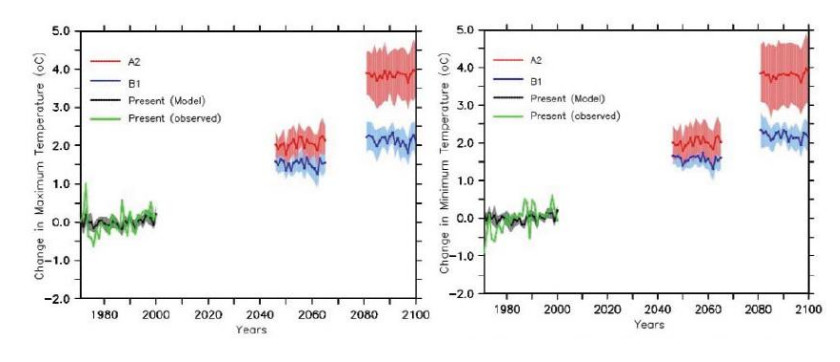









 DownLoad:
DownLoad:
